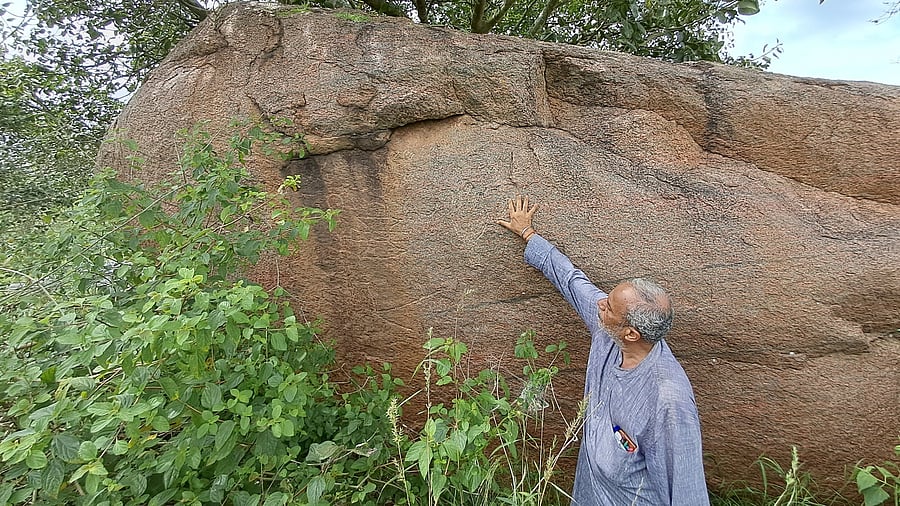
Kuduregundu, on which the inscriptions can be found; a close-up view of the carving.
Credit: Kirti Malhotra
During my trip to Kambalu in Bengaluru Rural, a villager had suggested a visit to the centuries-old Basavappa matha which, as per legends, gave its name to the neighbouring Basavapatna village.
This led me to look for them in the available archives. As per Mysore Archaeological Survey Report 1914-15 (MAS), an epigraph on a boulder called ‘kuduregundu’ located to the south of Basavapatna, Nelamangala taluk, makes this statement: ‘Om. The order of Bolabasavesvara. Anyone yoking the bull to the plough on a Monday shall be childless’. The epigraph is dated about 1700 AD.
The report talks of shrines dedicated to two Lingayat gurus, Bolabasavappa and his disciple Huchchabasavappa. It also says that Basavapatna was once a great city, the capital of a king whose elephants and horses were tied near Anegundu and Kuduregundu.
When I tried to search for the inscription in Epigraphia Carnatica Vol 9, 1905 AD, (EC9), I did not find it there. However, its supplement brightened my spirits, with its mentions of four inscriptions being on the Kuduregundu, and a line diagram of a shivalinga with ‘Om’ and ‘Basava’ etched in Kannada on its top part. The first inscription reads ‘Amrithalinga gangadhara’. Below it is the four-line second inscription mentioned above.
Credit: Kirti Malhotra
I set out to explore Basavapatna village. On the main road, I saw ‘Sri Bolabasaveshwara mathu Huchchabasaveshwara Kshethra’, inscribed within a compound wall, instead of a ‘groove’ as mentioned in MAS.
Once I entered the village, a local showed me the mud path leading to the huge boulders, almost a mile away. My chance meeting with a gentleman, Shiva Prasad, turned out to be good fortune. He knew exactly which one was Kuduregundu and which one was Anegundu. We went up and down the fields and through small water bodies, all the while listening to the sounds of peacocks.
Aware of the fast-approaching rain clouds, we first saw Anegundu and then moved quickly near Kuduregundu. Most of this boulder was covered in weeds and bushes. However, I could observe the line drawing of a shivalinga, exactly as shown in the EC9 supplement. A closer look revealed an inscription on top of it. The words were faintly visible, due to natural weathering over centuries. Back home, in the photos I had taken, I was surprised to see the carving of a hand near the shivalinga.
I made a second trip, and by sheer coincidence, I met Shiva Prasad again. As we arrived at Kuduregundu, I was able to clear the surrounding weeds and thorny plants. It was then that I noticed there were two shivalingas carved on this boulder. Below each of them, there is a line drawing of a plough. A keen observation shows the carving of a hand with a circle in the middle, next to the first shivalinga.
Credit: Kirti Malhotra
The hand with a wheel on the palm symbolises ‘ahimsa’ or non-violence in Jainism. Then, my attention went to the third inscription that the EC9 supplement mentioned. It reads: ‘Ranavijayasamastanu sallakhadalli’, which means that someone by the name ‘Ranavijayasamasta’ had fasted to death, taking the vow of ‘sallekhana’.
The second line drawing of a shivalinga is to the right of the first one. And there is a line drawing of a trishul next to it. Above and below the second shivalinga are the three inscriptions mentioned in the supplement.
The fourth inscription mentions the names ‘Veeramaheshwara Adhipati’ and ‘Bola Basavannaraya’. Though the second shivalinga, the two ploughs and the hand are not mentioned in EC9 or its supplement, they seem to belong to the same period, as they are related to the inscriptions mentioned in the supplement.
Shiva Prasad, my local guide, was unaware of the inscriptions. However, he mentioned that traditionally, bulls are not yoked on Mondays in the village. The hand symbol along with a shivalinga, could indicate the peaceful co-existence of people from different faiths, which is inspiring.